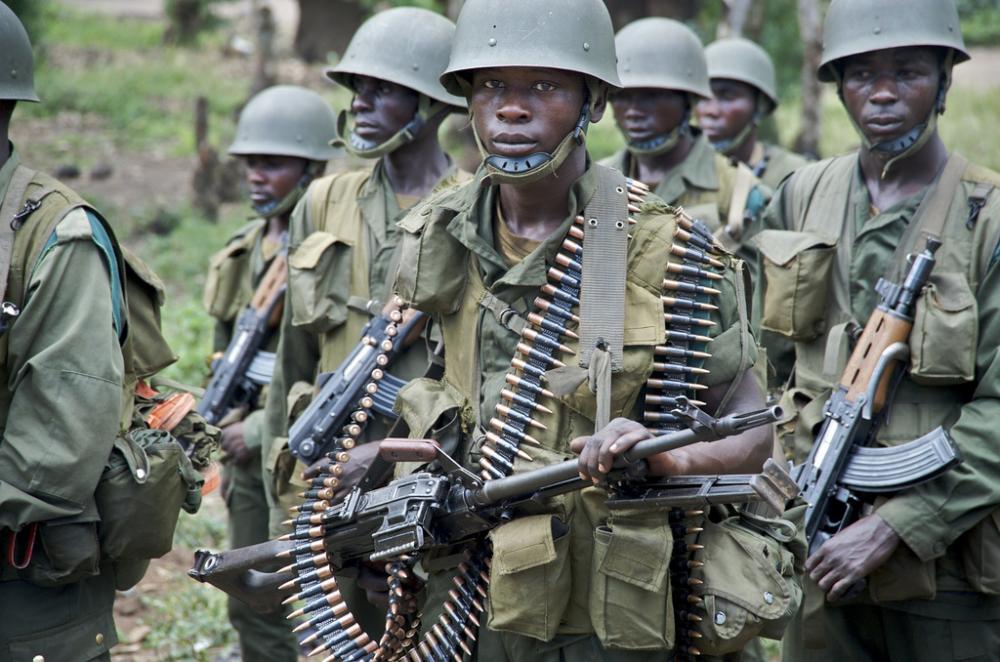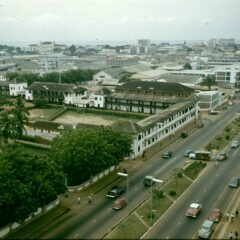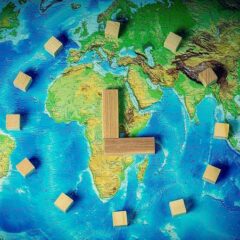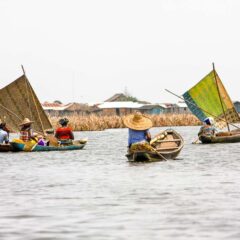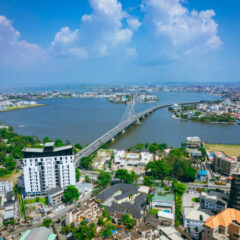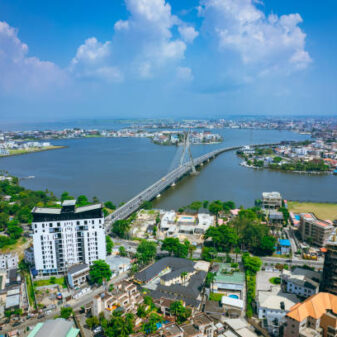Stereotypes. Every country in the world have managed to earn a few for itself. In many parts of the world, Americans are seen as obese and ignorant. Russians are perceived as cold, unfriendly warlike people. Nigerians, despite the overwhelming number of honest people, are internet fraudsters to many. Canadians, the polite younger brothers of the U.S and Asians are good at math. War and poverty is the stereotype the entire African continent has managed to earn for itself. As much as some people would hate, or even feel guilty to admit it, I’m from Africa evokes the image of someone who lives in a small village without internet and has to hunt for his food or a refugee fleeing from a war torn country.
Unfortunately, Africa has more than lived up to this stereotype. Armed conflict is still the continent’s biggest challenge.
According to OurWorldInData, a third of Sub-Saharan African countries were engaged in civil war in 1990..
The Uppsala Conflict Data Program (UCDP) States that there have been an estimated 630 state-based and non state armed conflicts on the continent between 1990 and 2015.
Below is a brief overview of some of the civil wars in Africa that changed the global perception of the continent.
1. The Ethiopian civil war (1974-1991)
The Ethiopian civil war was a conflict between the DERG Marxist-Communist government, led by Mengistu Haile Mariam, of Ethiopia and several opposition factions. Shortly after it’s overthrow of Ethiopia’s monarchy system, the communist government found itself beset by several oppositions, ranging from the conservative and pro-monarchy Ethiopian Democratic Union (EDU), to the rival Marxist-Leninist Ethiopian People’s Revolutionary Party (EPRP), and the ethnic Tigrayan People’s Liberation Front (TPLF). Following standard communist protocol, even against advice from the Soviet Union, it’s chief military support, the Derg initiated suppressive tactics, the Ethiopian Red terror, to suppress opposition, including the torture and murder of 30,000-750,000 suspected EPRP loyalists. An unfruitful enterprise that would backfire, turning frightened citizens to rebel sympathizers. Unlike most African civil wars, the EPLF was highly organized and disciplined. For example, in the midst of its revolt, the EPLF, which American intelligence considered to be the world’s most sophisticated guerrilla operation, conducted vaccination programs and mobile pharmacy units while fighting the soviet equipped communist government.
War with the rebels was just one of their many problems. Eritrean separatists had renewed their pursuits for independence, economic mismanagement had weakened their public support, Somalian warlords had invaded the eastern part of the country and the 1983-1985 drought brought widespread death. Together, all these weakened the government’s hold on power. By 1985, the rebels had considerable civilian support and most civilians moved to rebel controlled towns. In 1990, the communists had lost support from the soviet union and the rebels had control of most of Ethiopia and were on their way towards the capital. Mengistu was overthrown by his own officials and fled to Zimbabwe where he lives to this day.
2. The Nigerian civil war (1967-1970)
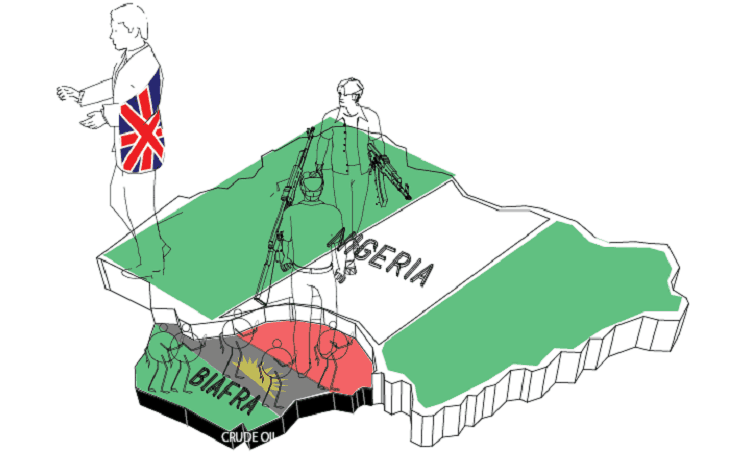
The Nigerian Civil war was a conflict between the Nigerian government and the Igbo people in the South-Eastern part of the country. The cause of the war borders around ethnic, cultural and religious differences between the major ethnic groups in Nigeria, south-eastern Igbo, northern Hausa-Fulani and the south-western Yoruba people. British colonists, for easier administration, had merged, and later, left startlingly different civilizations as one polity with the reins of power tilting heavily towards the north. The beginning of ethnic tensions can not be pinpointed, but violence broke out by 1966, after a failed military coup, which was perceived by the north as an Igbo attempt at power. Its retribution were mass killings of the people of the supposed power grabbing tribe residing in the north. About a hundred thousand people were dead by the end of the carnage. Two million more had fled back to the south-east. Peace negotiations failed as quickly as they were initiated, leading the south east to declare their independence from Nigeria, a decision rejected by the Nigerian Republic. This ultimately led to war (which had a lot of genocidal elements, the Asaba massacre one of them), in which the south-east surrendered.
3.The first Liberian civil war (1989-1996)
Following the pattern of most civil wars in Africa, tensions rose after President Samuel Doe, a member of the Krahn ethnic group, was perceived by the Gio and Mano people of treating his kin preferentially, these tensions heightened in 1985.
After a failed coup, Doe increased his persecution of the already aggrieved ethnicities, driving them to Charles Taylor’s growing insurgency group, later known as the National Patriotic Front of Liberia (NPFL). The rebels invaded Nimba county on Christmas eve of 1989.
President Doe countered, sending two AFL battalions to crush them. Putting into consideration the popular Monrovia church massacre, the AFL counter was brutal to the point of barbarism. But it ultimately failed to accomplish its goals. Another NPFL assault cost the AFL the strategic town of Gbarnga which the rebels used as their major base to siege the capital.
16 ECOWAS countries sent a peacekeeping force in 1990 to Liberia, in a bid to prevent the conflict from spreading outside the country. On his way to the peacekeeping headquarters, President Doe was captured and killed, after being tortured, by the INPFL, an offshoot of the NPFL created by Prince Yormie Johnson. With Doe gone, the INPFL and NPFL turned on each other and ECOWAS peace attempts made no progress. Another faction, The United Liberation Movement of Liberia for Democracy (ULIMO), made up mostly of Krahn ethnicity and supporters of the late president, sprung up around 1991. ECOWAS managed to achieve a brief ceasefire in 1995, and in 1997 a general election was held. An election Charles Taylor won by a landslide, thanks to his intimidation tactics.
4. The Ugandan Civil war (1980-1986)
Idi Amin’s war and subsequent annexation of Tanzanian lands in 1978 had backfired.
In 1979, victorious Tanzanian soldiers and the Uganda National Liberation Army (UNLA), a former power ousted by Amin, occupied the nation’s capital and re-assumed power while the former dictator fled to Libya after an incoherent radio speech. In 1980, decentralized rebels and Amin loyalists attacked a parading UNLA garrison in Koboko. The Army retaliated, sparing neither rebels nor civilians. Thousands fled to Sudan and Congo and hundreds armed themselves against the government, joined the rebels and took the west Nile region. The Ugandan bush war had started.
That same year, Milton Obote, the president overthrown by Idi Amin and leader of the UNLA, won the election, making him the president once more, he attempted to repress dissidents again, particularly Yoweri Museveni, who challenged his dubious victory. In this time, three new opposition factions sprung, Museveni’s Popular Resistance Army (PRA), Yusuf Lule’s Uganda Freedom Fighters (UFF), and Andrew Kayira’s Uganda Freedom Movement (UFM). Museveni and Yusuf would merge to form the “National Resistance Movement” (NRM) and its armed wing was termed the “National Resistance Army” (NRA).
The NRA was the main enemy of Obote’s regime. Despite inciting the war, the west Nile rebels had all but collapsed within a year. Infighting had done the government’s job. The UNLA encountered little resistance in retaking the region in late 1981.
Things went bad for Milton Obote in 1983. His Chief of staff, a man who had held his government together, died in suspicious circumstances. Rumours that Obote was responsible for his death, a rumour the NRA used to its advantage, damaged the President’s reputation. Division turned to rebellion and rebellion to revolt. Lieutenant General Bazilio Olara-Okello’s short-lived government seized power and drove Milton out of Uganda in 1985. The NRA capitalized on the chaos and drove the new government out the following year. Museveni declared the war to be officially over.
5. The Sierra Leone Civil War (1991–2002)
Perhaps you have an idea of this war from Leonardo DiCaprio’s 2006 movie, Blood Diamond or from Kanye’s award winning song; Diamonds from Sierra Leone. Both were inspired by a decade long conflict in Sierra Leone.
Sierra Leone, which had previously prospered under prime minister Milton Margai, had become crippled under the tenures of Albert Margai (nicknamed “The fat, wild man), Steven Siaka, and Joseph Momoh.
These three brought the country much ruin; so much that a few years before the war, the education system had collapsed and the entire Sierra Leonean population was out of school. Hordes of the aggrieved jobless population joined Fodah Sankoh’s Revolutionary United Front (RUF), a rising insurrectionist movement that tapped into the population’s resentment for the government. Despite the facade of having the people’s interest at heart, the RUF were no less than organized bandits. Their brutality on civilians was no different to that of the military. Furthermore, soldiers of the Sierra Leonean Army (SLA) were largely indistinguishable from the RUF; switching sides whenever it favored them.
Diamonds would become a major bone of contention and what would escalate this simmering conflict.
It was discovered in 1930. Like all resources they could get their hands on, it had been wantonly plundered by the government at the expense of the people. Now all sides depended on the diamonds; insurrectionists used it to purchase weapons and so did the government. Despite their weak numbers and poor weaponry, the RUF’s struck first and the government couldn’t stop them. by the end of 1991, they were in control of more than half of the country.
With the SLA and RUF fighting and competing on who could mete out more barbarism on civilians, any semblance of authority or credibility the government held vaporised. One year into the war, Joseph Momoh was overthrown and replaced by Valentine Strasser’s National Provisional Ruling Council (NPRC) which promised immediate peace and total victory. A promise that proved to be hogwash.
For the people, a brief trickle of relief, in the form of the Kamajor Militia Rose to defend them from both SLA and RUF soldiers.
In 1993, Nigerian Soldiers provided by ECOMOG succeeded in pushing the RUF from major strongholds to the country’s borders. A success that was soon reversed as corruption, low wages and the fact the government did not want the war to end, forced soldiers to start trading with rebels and parts of the recaptured territory were lost.
Another counter-coup, this time by RUF and disgruntled SLA soldiers led by Major Johnny Paul Koroma overthrew the usurper. This coup was largely condemned by the international community. A series of offensives by foreign interventionists; most particularly Operation Khukri and Operation Palliser forced the rebels to make peace.
6. Rwandan Civil War
A list of civil wars in Africa that painted Africa’s face without the Rwandan Civil War is an incomplete list. Hotel Rwanda, a film that was nominated for multiple Academy Awards, is on the American Film Institute’s list of the 100 most inspirational films of all time, and also appears on the IMDb’s Top 250 highest rated movies of all time, was a movie talking about the Rwandan genocide which took place during the war, imagine how that painted Africa. More movies and songs exist that talks about the war and genocide, one of those songs is Million Voices by the Dialo star, Wyclef Jean.
Unlike like most of the civil wars in Africa, one of the major reasons for the Rwandan civil war was class and not tribal reasons as many believe. The reason for the war dates far back to Rwanda’s beginning. Germany, in order to control the Rwandan populace created a system that divided the people by class. They gave the Tutsi monarchy military support, and the Tutsi social class, administrative roles. This led to a widened a minor class divide that existed between the Hutus and the Tutsi tribe.
During the World War 1, Belgian forces took hold of Rwanda and began a direct form of colonization, a different type which the Germans had practised. The Belgians backed the Tutsi class until they wanted an independence that favored their class, then the Belgians backed the Hutus. In 1959, the Hutus led a revolution called the Rwandan Revolution which saw the aggressive and violent transition of power from the Tutsi minority class to the Hutus majority class.
Due to the violent revolution, at least 336,000 Tutsis ran away to neighboring countries, becoming refugees.
The Rwandan Patriotic Front (RPF), formed by the Tutsi refugees in Uganda attacked Rwanda on October 1st 1990, this led to the start of a war that temporarily ended in 1993 due to the of efforts of Organisation of African Union (OAU) now known as African Union (AU).
In 1994, the plane which the president of Rwanda and Burundi were aboard was shot down by a missile rocket, and they both died, this led to war again and the Rwanda genocide targeted at the Tutsi people. Over one million people were killed, the one million people consisted of Tutsis, Twas and moderate Hutus.
7. The Congo wars
A list bereft of the first and second Congo wars is incomplete. Nicknamed the World War of Africa, the second Congo war is the bloodiest conflict since World War II.
Ethnic conflict between the Tutsi and Hutu people of Rwanda had spilled over to Congo through migration. The Rwandan genocide had forced hordes of Tutsi refugees into Congo, and an overthrow of the Hutu government saw a second migration, this time of the Hutu people. The two warring ethnicities continued their rivalry overseas as the Hutu resumed attacks on the Tutsi refugees, the earlier Tutsi migrants in Congo (known as Banyamulenge, meaning Ancient foes of the Native people of Congo), as well as the Rwandan patriotic front (RPF).
With support from the RPF and its allies, in response to Congo’s government support of the Hutus, Banyamulenge elements and non-Tutsi militias coalesced into the Alliance of Democratic Forces for the Liberation of Congo (AFDL) and overthrew the government of Congo.
In the 90’s, Congo was a cesspool of poverty, lawlessness and ethnic hatred. After the overthrow of Mobutu’s government, things changed very little.
Most of the native Congolese saw Kabila, the new president, as a puppet of foreigners. When the president desperately tried to change public opinion by expelling all Rwandan and Ugandan soldiers, his former allies, the Banyamulenge people revolted, supported once more by the Rwanda government leading to war breaking out. Unlike the first war, the second Congo war attracted allies to Congo. Angola, Chad, Namibia and several militias supported the Kabila government. The Banyamulenge people and the Congolese government agreed on a ceasefire and peace negotiations after five years of rape, starvation and ethnic cleansing.
8. Sudan Civil War
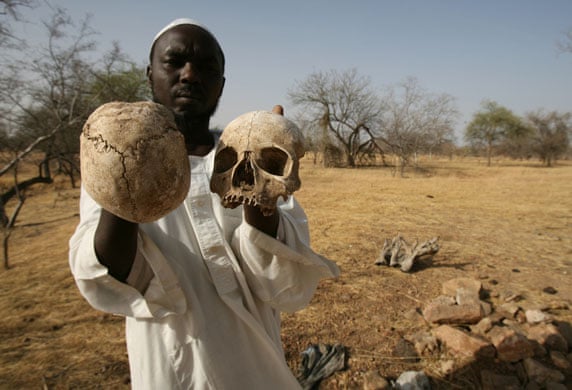
Photograph: Nasser Nasser/AP. Retrieved from: Theguardian
The fact that the Sudan civil war raged on since 2003 till 2020 is one of the reasons this conflict stands out from the rest of the civil wars in Africa on this list. The Sudan civil war started when the Sudan Liberation Movement/Army (SLM/SLA) and the Justice and Equality Movement (JEM) took up arms against Sudan, accusing the state of marginalizing the western region, Dafur.
The war earned the then-president of Sudan, Omar al-Bashir, a warrant for war crimes, crimes against humanity and genocide from the Hague-based International Criminal Court (ICC).
In September 2016, Omar announced to the world that peace had returned to Dafur but reports from rights group, Amnesty International, said that Khartoum was carrying out several chemical attacks, killing civilians in the west region of the country.
On April 11 2019, Bashir was ousted by the military and was detained after months of popular protests demanding for his resignation.
On July 28 2020, the United Nations–African Union Mission in Darfur (UNAMID) called on the new Sudan government to deploy security forces in Darfur as soon as possible, after a series of killings. Currently, the government and the rebels are planning to sign an accord that aims to end the 17 years war.
Impacts of the civil wars in Africa
Ethnic based wars last longer than ideological wars as generational hatred continues even when guns stop firing. The ghost of the Nigerian civil war still haunts the nation. The country’s rapidly cascading economy and a president, considered a tribalist by many, has flowered the rise of nationalist and separatists movements. In 2017, the country was thrown in a pensive state as a coalition of Northern groups gave all Igbo’s three months to leave the north or risk a repeat of the 1966 massacre.
The Liberian civil war saw one of Africa’s bloodiest and most severe human rights violations, particularly the barbaric acts of General Butt Naked, a fetish priest, nicknamed so for his habit of going into battle naked. An act he believed, protected him from bullets. When he wasn’t fighting naked, he was offering children as sacrifices or sending them to war, naked. In his own words:
“Before leading my troops into battle, we would get drunk and drugged up, sacrifice a local teenager, drink the blood, then strip down to our shoes and go into battle wearing colorful wigs and carrying imaginary purses we’d looted from civilians. We’d slaughter anyone we saw, chop their heads off and use them as soccer balls. We were nude, fearless, drunk yet strategic. We killed hundreds of people—so many I lost count.”
UNLA’S 1982 offensive into the Nile region caused widespread destruction with 260,000 people fleeing the region. UNLA’S Operation bonanza in the northern NRA region displaced most of the civilians. An estimated 1,000,000 people were displaced in Uganda’s civil war; with an estimated 300,000 civilians murdered.
With the government spending, or claiming to spend, almost $100million dollars a year, money meant for domestic growth was redirected for military expenditures. The war has been singled out as the major reason for underdevelopment in Uganda.
Sierra Leoneans witnessed shocking human rights violations. Citizens were murdered in the most barbaric wars, including locking them in a burning house. Many child soldiers were forced to kill their families, and overwhelmed with violence to desensitize them. An estimated number of 257,000 women were raped or used as sex slaves.
The full consequences of civil wars in Africa can’t be comprehended on paper as atrocities are numbed down in writing and lives lost are written in alexithymic words. War remains an ugly thing and the countless civil wars Africa has had definitely left no impact on the continent.
